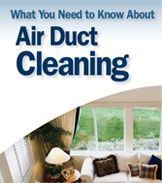Improvements in energy efficiency and the environment have occurred as the result of countless small initiatives. One of these small initiatives is HVAC Systems Cleaning – which improves air quality, specifically indoor air quality, and improves energy efficiency by improving the performance of HVAC Systems and increasing air flow.
“Remove the sources of the allergens”
is what HVAC Systems Cleaning or Duct Cleaning does – it removes the numerous sources of allergens or contaminants that exist in HVAC Systems.
Contaminants like molds, bacteria, fiberglass insulation fibers, dust and debris are all present in your ductwork and given that the ductwork is the lungs of your buildings these contaminents can all easily be dispersed into the ambient air for the building occupants to inhale.
areas where contaminants can accumulate. Large air handler units, terminal boxes installed throughout the system that can be collection points for dirt and debris, ductwork layouts that have 90 degree turns with turning vanes and the existence of fire and smoke dampers where dirt and debris can also accumulate.
The increased likelihood of the entrance of moisture to the HVAC System through outside air intakes, sitting water in drain pans, and many other devices in the system also produce potential indoor air quality problems. The combination of moisture and dirt in ductwork can lead to microbial growth, the potential microbial growth can be amplified with the existence of ductwork is internally insulated with fiberglass insulation – which is common in commercial ductwork installations.
A study by researchers at Johns Hopkins University found an association between increasing levels of indoor particulate matter pollution and the severity of asthma symptoms among children (click link above for details of the study).
The complexity of large commercial HVAC Systems increases the potential
A Washington Post article titled “Indoor Air Quality is a Top Health Risk” states “The Environmental Protection Agency has declared the air two to five times as polluted indoors than out, and placed it among the top five environmental risks to public health.” The article continues by citing a spokeswoman for the American Asthma and Allergy Foundation of America, who stated, “The best thing you can do to improve indoor air quality is to put some elbow grease into it,” the spokeswoman continues, “Remove the sources of the allergens….”
Energy Efficiency
In 2005 the American Society of Heating, Refrigerating and Air-Conditioning Engineers, Inc. (ASHRAE) conducted a study to determine the effectiveness of coil cleaning vis-à-vis energy savings.
The differences between residential HVAC systems and commercial HVAC systems are many. The demands placed on the contractor tasked with cleaning the HVAC System are just as diverse.
Commercial HVAC Systems are much more complex – there are multi-zone and dual duct systems, VAV boxes and mixing boxes, turning vanes and fire dampers, and air handler units housed in penthouses not closets. Aside from the added complexity of the system layout there are additional nuances in commercial duct cleaning; having to manage infection control procedures to protect the well being of patients when cleaning ductwork in a hospital, or working thirty feet in the air and utilizing proper OSHA fall-protection measures to clean the ductwork in an industrial plant.
Given the complexities and differences in the cleaning of commercial HVAC Systems it is important to find a company with the right mix of training and experience.
RPM has performed commercial duct cleaning projects for some of the largest companies in the United States; projects in Industrial Plants, Colleges, Hospitals, Office Buildings, Schools (K-12), and many other types of commercial installations.
Combined with that experience RPM is a member of the National Air Duct Cleaners Association (NADCA) with multiple NADCA Certified “Air Systems Cleaning Specialist” on staff as well as American Indoor Air Quality Council “Certified Mold Remediator” and “Certified Indoor Environmentalist” on staff. Additionally, RPM’s technicians have been through OSHA Training.
The studies show the benefits to Indoor Air Quality and Energy Savings after cleaning the ductwork in your building. So contact RPM, the specialist in commercial duct cleaning to receive an estimate and start reaping the benefits today!
The purpose in large part was that logically and theoretically it was known that coil cleaning provided energy savings by increasing air flow and reducing stress on the HVAC System and in turn reduces stress (energy) on the system to operate. There was however no hard data or research to back up this assertion. The study was conducted at a 34 story building on Times Square in New York City. The findings were incredibly definitive showing that proper cleaning not only improved energy efficiency but helped indoor air quality (click link above for detailed findings of the study).
The building is serviced by four air handler units, the study found that detailed cleaning of one unit would yield annual savings of $40,000.00 just from the one unit!Additionally dirty ductwork can load filters quickly and lead to more stress on the air handler and potentially higher energy costs, blockages in reheat coils, mixing boxes, VAV boxes and other terminal boxes found in commercial HVAC systems can also restrict airflow.
Why should you choose RPM for your Commercial Duct Cleaning Needs?
If you are looking for a commercial duct cleaning contractor to improve the indoor air quality in your building, save on energy, or both it’s important that you secure a contractor that specializes in commercial air duct cleaning, RPM is the contractor to choose.

